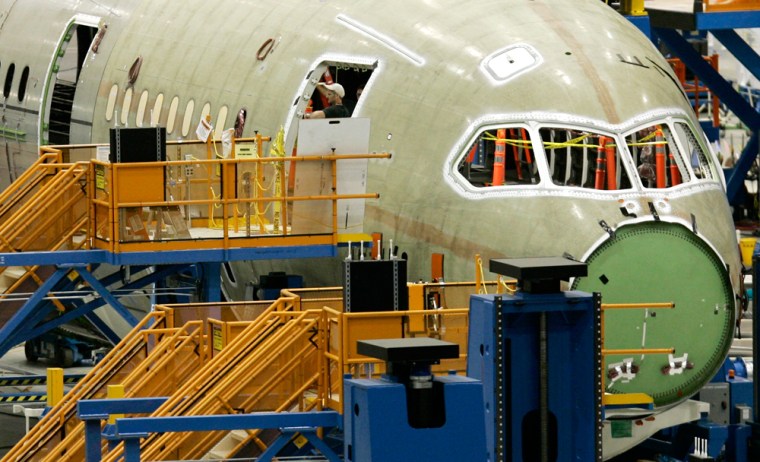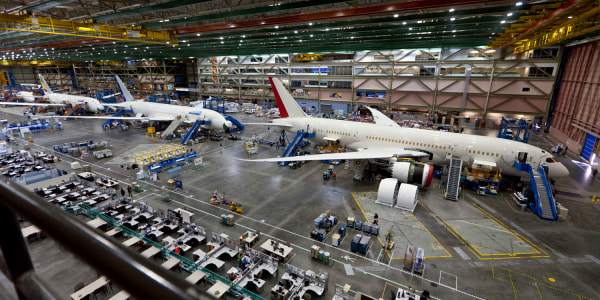Boeing’s humiliating confession Wednesday that its 787 Dreamliner will be six months late for initial deliveries underscores the intense pressure the company faces in getting its revolutionary new passenger jet in the air.
The stakes have rarely been higher for Boeing, which has pushed the envelope many times in its 91-year history. The 787 is a $10 billion gamble to reinforce the company’s standing as the world’s most innovative and successful builder of commercial airplanes.
While Boeing officials are being praised for “biting the bullet,” industry insiders say the delivery delay chips away at Boeing’s credibility and dampens the company’s efforts to overcome European rival Airbus Industrie for preeminence in the global aerospace industry. Boeing’s integrity already took a hit a few years ago when it decided against developing a super-jumbo jet to counter Airbus’ double-decker A380.
But Airbus, which plans to deliver its first A380 to Singapore Airlines on Monday, also has had its share of production problems and delays. The A380 — the world's biggest passenger jet — is nearly two years behind schedule because of improperly installed wiring.
Now the tide has turned against Boeing. The first 787 won't be delivered until November or December 2008 instead of May. And the airplane won’t fly until March at the earliest, at least six months behind schedule.
Slideshow 24 photos
Boeing rolls out 787
“The real danger to Boeing now is what happens going forward,’’ said aerospace analyst Scott Hamilton, managing director of Seattle-based Leeham Co. “It’s the unknowns that can prove to be the killer.”
The persistent production delays, parts shortages and supplier snafus that have eroded the program’s margin for error could end up hindering the crucial program to win certification needed to put the plane in commercial service.
“Until the first production plane rolls out the factory door, it’s hazardous to say all is well,’’ Hamilton wrote in a special report Wednesday. He noted that the flight test program could still turn up something unexpected that would result in costly and time-consuming rework. “There are still a million things that could go wrong between now and first delivery.”
Last month Boeing postponed the first test flight to mid-November or mid-December because of assembly problems and difficulty with flight-control software. That would have left the company just five to six months before the scheduled first delivery, or about half the time it took to test the 777 a decade ago.
Boeing hopes that by restructuring the 787 program and pushing back the first flight even further, it will be able to detect and deal with the “unknowns.”
“They are giving themselves a respectable margin this time,’’ said Richard Aboulafia, vice president for analysis at Teal Group, a Fairfax, Va.-based aerospace research company. “It’s better to get it good than get it on time.”
The bad news, however, is that Boeing added no margin for its extremely aggressive production schedule, Aboulafia said. Boeing still plans to deliver 109 Dreamliners by the end of 2009, a reduction of only three from its original plans.
So far it looks like Boeing can get by with just a bruised corporate ego and its credibility still intact. But all that could change with further hiccups. So far the company's stock is down only about 9 percent from its recent peak of just over $106 this month.
“The stock market reacted mildly because Boeing has been reasonably forthcoming so far, but any additional delays are not likely to be received as well,’’ Hamilton wrote.
As recently as a few days ago, Boeing’s vice president of marketing continued to say All Nippon Airways would receive its launch order on time next May. (A spokesman for All Nippon said the airline was obviously disappointed by the delay, adding, “We hope to keep the impact to a minimum.”)
It’s not clear whether Boeing officials were in denial, ill informed or just hoping against hope. “It just became very obvious that no matter how much they wanted to keep suppliers’ feet to the fire, they had to come clean,’’ said Aboulafia.
He said the delay eventually could affect Boeing’s bottom line, but he still has confidence in the ultimate product. “This is still a plane that will help reinvent the industry,’’ Aboulafia said. “It still has very promising performance and no direct competitor.’’
Airbus’ competing A350 XWB has run into its own set of design problems and is five years behind the 787.
The 787 is the company’s first all-new commercial jetliner since the twin-engine 777 rolled out in 1994, and it's Boeing’s first passenger model built primarily of man-made carbon-fiber reinforced plastic, known as composite, rather than metal parts.
It’s too soon to tell how Boeing’s airline customers will deal with the delays, but Boeing surely will be paying hefty late-delivery penalties.
Continental Airlines, which has orders for 25 787s, said it doesn’t yet know what impact, if any, Boeing’s delay will have on the airline, which originally was scheduled to begin getting the models in 2009.
“Boeing is a long-term, valued business partner,” Continental Chairman and CEO Larry Kellner said in a prepared statement. “The Boeing 787 Dreamliner is destined to be a game changer, and its impact on global aviation is going to be significant for decades to come.’’
The 787 has already racked up more than $120 billion worth of airline orders, making it the biggest-selling new commercial jet in history.
But Boeing is far from being able to cash in. The company still must prove to its shareholders, federal regulators, airlines and the flying public that its Dreamliner can fly higher, faster, farther and more cheaply than its aluminum predecessors and competitors.
To do so, Boeing is relying heavily on more than 50 suppliers that are working 24 hours a day at 135 sites on four continents designing and building parts for the new plane.
“Boeing is still not out of the woods,’’ Hamilton said.

